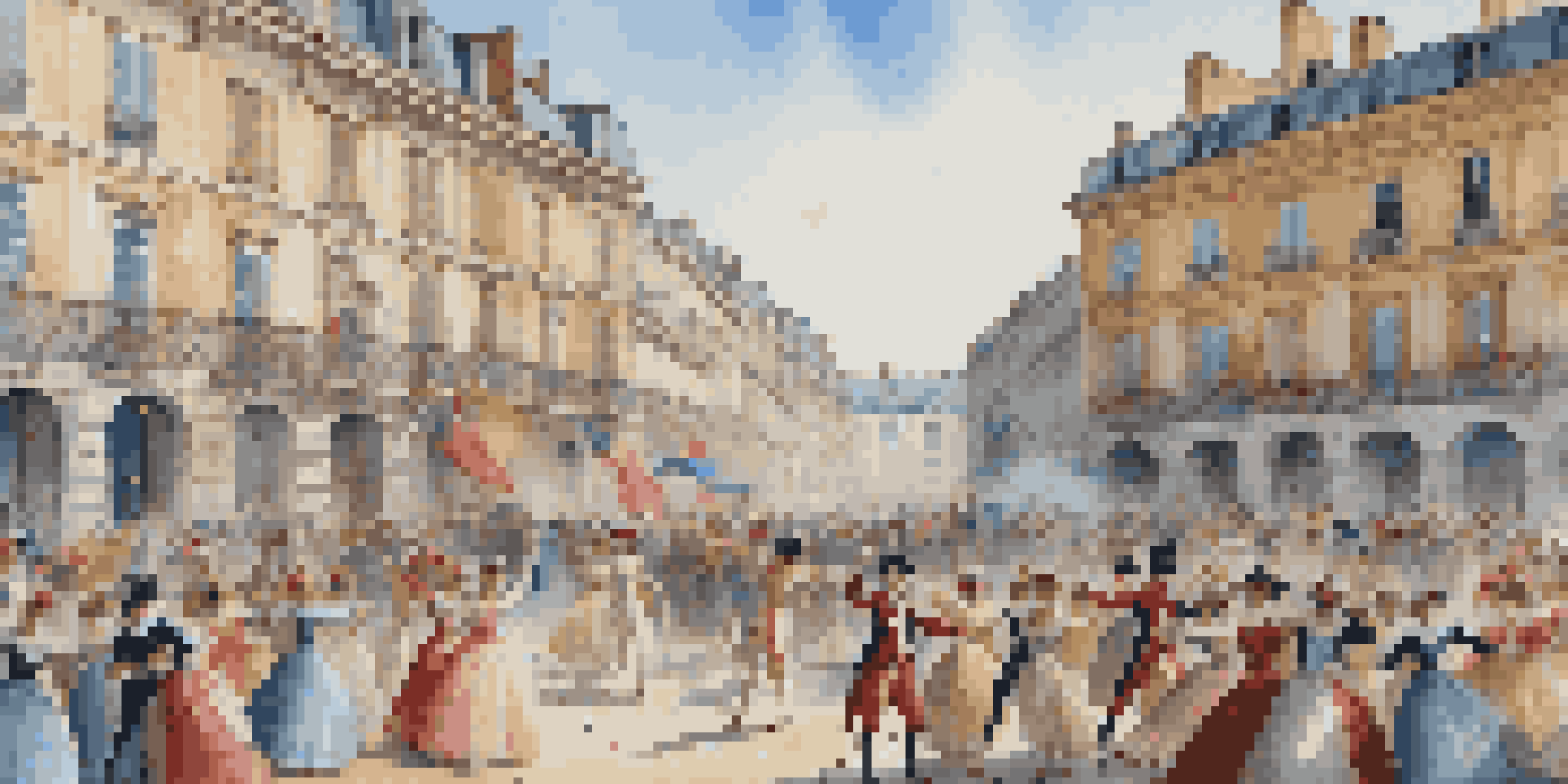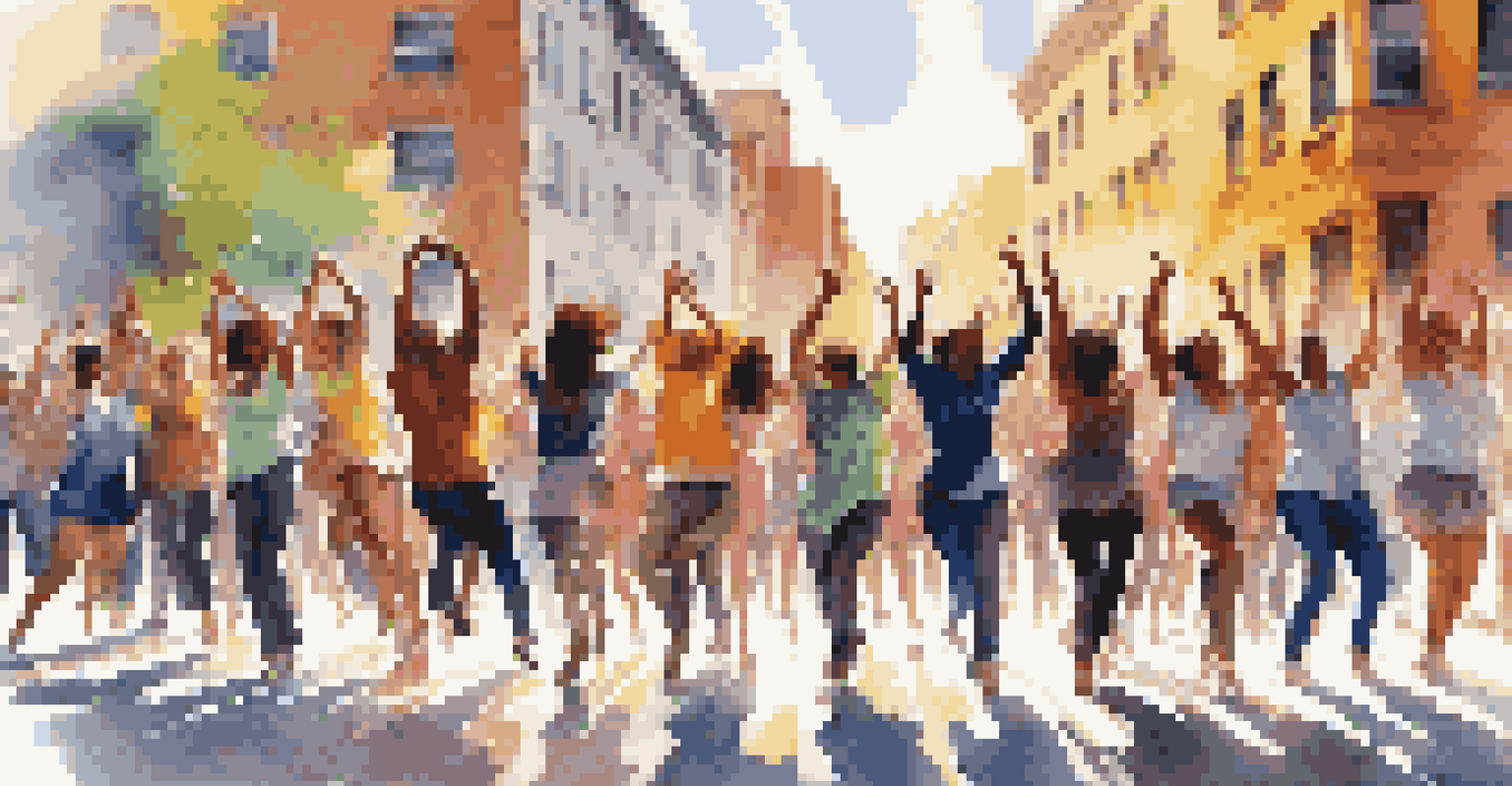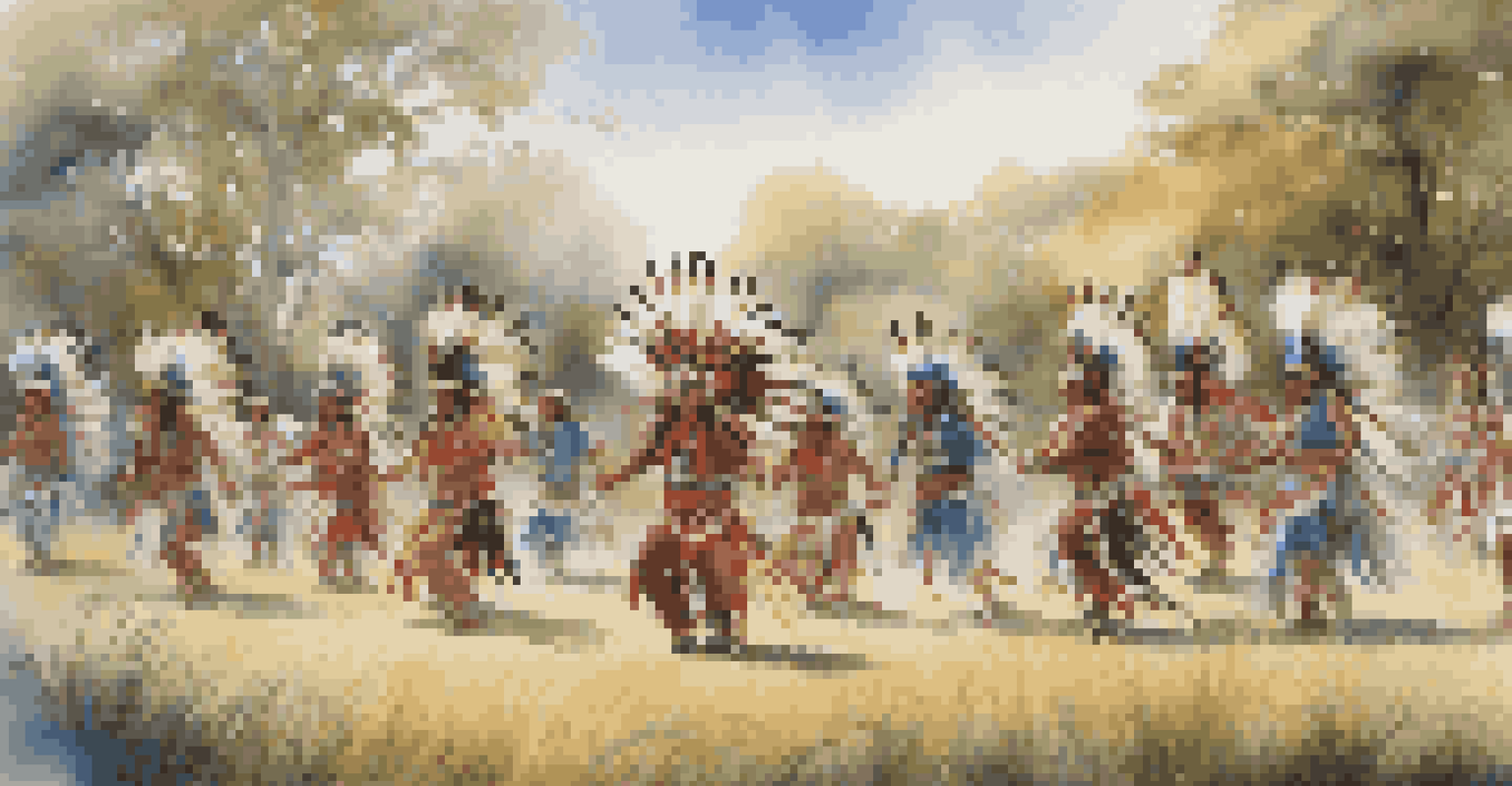The Role of Dance in Historical Revolutionary Movements

Dance as a Tool for Unity in Revolutions
Throughout history, dance has served as a powerful tool for unity among people. When communities come together to dance, they create a shared experience that transcends individual differences, fostering a sense of belonging. This collective spirit can be crucial during revolutionary movements, where solidarity is key to galvanizing support and action.
Dance is the hidden language of the soul.
For example, during the French Revolution, dances like the 'Carmagnole' became emblematic of the revolutionary spirit. These dances not only entertained but also united people in their common cause, reinforcing their shared identity and purpose. The rhythm and movements allowed individuals to express their emotions and aspirations in a way that words sometimes could not.
Similarly, in more recent times, dances have played a role in movements such as the protests in Egypt during the Arab Spring. The spontaneous dancing in Tahrir Square showcased the joy and defiance of the people as they stood against oppression, illustrating that dance can be both a form of protest and a celebration of freedom.
Dance as a Means of Political Expression
Dance has often served as a medium for political expression, allowing communities to voice their dissent and hopes without the constraints of spoken language. Through choreography and performance, dancers can convey powerful messages that resonate with audiences on both emotional and intellectual levels. This form of expression is particularly vital in societies where direct political commentary may be censored.

Take the example of the 'Tango' in Argentina, which emerged during a time of social upheaval. The dance's passionate movements and themes of longing reflect the struggles of the Argentine people during periods of dictatorship. Tango became not just a dance but a symbol of resistance and resilience, capturing the essence of a nation’s fight for freedom.
Dance Unites Communities in Struggle
Throughout history, dance has brought people together, creating a shared experience that fosters solidarity during revolutionary movements.
Moreover, in the United States, the Harlem Renaissance saw African American artists utilize dance as a means of asserting their identity and advocating for civil rights. Through performances that highlighted African heritage and culture, dancers challenged societal norms and transformed the narrative surrounding race and equality.
Choreography as a Form of Revolutionary Art
Choreography can be a powerful form of revolutionary art that captures the essence of a movement. Dancers often choreograph pieces that reflect the struggles and aspirations of their communities, creating a visual and emotional representation of their fight for change. This art form not only entertains but also educates and inspires others to join the cause.
We should consider every day lost on which we have not danced at least once.
One notable example is the works of Martha Graham, who used her choreography to address social issues and human experiences. Her pieces often conveyed themes of struggle, resilience, and hope, resonating with audiences and encouraging them to think critically about societal issues. This approach illustrates how dance can transcend entertainment and become a catalyst for social change.
In contemporary contexts, companies like the Alvin Ailey American Dance Theater have used their performances to highlight African American experiences and social justice issues. Their work not only entertains but also serves as a reminder of the ongoing fight for equality, showcasing how choreography can be deeply intertwined with revolutionary ideals.
Rituals and Dance in Indigenous Resistance
For many indigenous cultures, dance is deeply rooted in rituals and traditions that embody resistance against colonialism and oppression. These dances often celebrate cultural identity, history, and spirituality, serving as a reminder of resilience in the face of challenges. By preserving these traditions, indigenous communities assert their right to exist and thrive.
Take the Powwow, a gathering of Native American communities where dance plays a central role. These events celebrate culture, heritage, and identity while also serving as a form of resistance against historical injustices. Through vibrant dances and music, participants express their pride and unity, reinforcing their cultural significance in a modern context.
Dance as Political Expression
Dance serves as a powerful medium for political expression, allowing communities to voice dissent and hope without the constraints of spoken language.
Similarly, the Maori haka, a traditional war dance from New Zealand, exemplifies the power of dance in expressing strength and solidarity. The haka has gained international recognition, often performed at significant events, showcasing the resilience of the Maori people and their commitment to preserving their cultural identity against colonial pressures.
The Role of Dance in Modern Protests
In the digital age, dance has found new life as a form of protest during modern movements. Social media platforms allow dancers to share their messages with a global audience, amplifying their voices and connecting with supporters far beyond their local communities. This has led to the emergence of viral dance challenges that highlight social issues and mobilize action.
For instance, the 'Black Lives Matter' movement has seen participants use dance to express their messages of justice and equality. Choreographed dances shared on platforms like TikTok have become a way for individuals to engage with the movement, showcasing solidarity and raising awareness about systemic racism. This modern fusion of dance and activism creates a vibrant space for dialogue and connection.
Moreover, flash mob dances have emerged as spontaneous forms of protest, drawing attention to social causes in a unique and engaging way. These unexpected performances in public spaces create visual spectacles that can disrupt the norm and provoke thought, illustrating how dance continues to adapt and evolve in the context of activism.
Dance as a Reflection of Societal Change
Throughout history, dance has not only influenced revolutionary movements but has also reflected the societal changes that accompany them. As cultures evolve, so do their dance forms, often mirroring the political and social landscapes of the time. This dynamic relationship helps to document history in a way that is both engaging and meaningful.
For example, the emergence of the Charleston during the Roaring Twenties reflected the cultural shift towards liberation and modernity in post-World War I America. This lively dance symbolized a break from traditional norms and embraced a newfound sense of freedom, paralleling the social changes occurring in society, particularly among women.
Global Unity Through Dance
Dance transcends borders, uniting diverse cultures in their struggles against oppression and fostering a shared sense of purpose in revolutionary movements.
Today, genres like Hip-Hop continue to reflect ongoing societal changes, often addressing issues like inequality and injustice. This dance style has roots in marginalized communities and serves as a powerful medium for storytelling, allowing dancers to express their experiences and perspectives while pushing for change.
The Global Influence of Dance in Revolutionary Movements
Dance is a universal language that transcends borders, making it a powerful tool for global revolutionary movements. Different cultures have used dance to express their struggles and unite against oppression, creating a rich tapestry of movements that inspire solidarity across nations. This global influence showcases the interconnectedness of humanity in the fight for justice.
For instance, during the anti-apartheid movement in South Africa, traditional dances were used to unite people in their struggle for liberation. These dances not only celebrated cultural heritage but also served as a form of resistance against the oppressive regime. The global community was drawn into this narrative, demonstrating how dance can bridge cultural divides and foster a sense of shared purpose.

Similarly, the globally recognized 'Dance for Our Lives' initiative highlights how dance can unite individuals from different backgrounds in the fight against various social issues. By bringing together dancers from across the globe, this movement emphasizes the power of collective action and the ability of dance to inspire change on a worldwide scale.